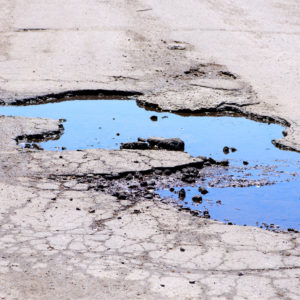Voters and policymakers bemoan our crumbling roads, airports and public transit systems, but few jurisdictions do much about it. The odd thing is that historically low interest rates now make it cheap to fix or improve our public facilities. The mystery is why decision-makers have passed on this opportunity.
The sorry state of the nation’s roads, bridges and public infrastructure has been widely reported. Every few years the American Society of Civil Engineers draws up a report card on U.S. infrastructure, highlighting its strengths and shortcomings in a variety of areas — drinking water systems, wastewater, dams, roads, bridges, inland waterways, ports. The report card spotlights areas where spending on maintenance falls short of the amount needed to keep our infrastructure functioning efficiently. For many kinds of infrastructure, a bigger population and heavier utilization require us to invest in brand-new facilities. In its latest report card, the ASCE awards our public infrastructure a grade of D-plus.
It’s hard to think of a time more attractive for public investment than years when total demand for goods and services is depressed. The Treasury’s borrowing cost for investment funds is near historical lows. Since 2011, the interest rate on 10-year government bonds has averaged 2.3 percent. Savers buying inflation-protected bonds have been willing to lend funds to the federal government at a real interest rate of just 0.22 percent.
So long as there is excess unemployment, especially in the building trades, the labor resources needed to fix or improve public facilities should be abundant and relatively inexpensive. Employment in the construction industry has rebounded as home building and business investment have improved. Nonetheless, construction employment has recovered only half the loss it experienced between its pre-recession peak in 2006 and its post-recession low in 2011. Skilled labor is not nearly as abundant as it was in 2011, but the trend in wage inflation does not suggest employers are bidding up worker salaries.
The federal government’s failure to use fiscal policy and, in particular, public investment policy to bring the nation closer to full employment represents a notable lapse in policymaking, perhaps the most grievous lapse since the crisis began. It unnecessarily prolonged the suffering of the nation’s long-term unemployed and it wasted a rare opportunity to rebuild the nation’s public infrastructure at relatively low cost.
Why did this failure occur? One reason is that policymakers were too optimistic when the financial crisis took place back in 2008. Most public and private forecasts at the time understated the severity of the economic fallout from the bank meltdown. Decision-makers in Congress and the administration may have believed infrastructure investment would be unhelpful in the recovery. Well-conceived infrastructure projects take many months to design and many years to complete. Policymakers may have believed the economic crisis would be over by the time federally infrastructure spending reached its peak.
When forecasters and Democratic policymakers recognized their error, voters had elected a Congress that supported only one kind of fiscal policy to deal with the crisis — big tax cuts focused on high-income taxpayers. Whether or not such a policy could have been effective, it would not make additional funds available for infrastructure projects.
Harvard’s Lawrence Summers and Rachel Lipset recently pointed to another reason voters have failed to back a big program to boost infrastructure investment — government ineptitude. In the Boston Globe they documented the painfully slow progress of the Massachusetts Department of Transportation in overhauling a bridge across the Charles River. The bridge, which was built over 11 months back in 1912, has so far required four years for its reconstruction. No end date is in sight. In addition to the over-budget cost of the project, the overhaul has also caused massive and highly visible inconvenience for drivers, cyclists and pedestrians trying to move between Boston and Cambridge.
Few readers can be under the illusion Boston’s experience is exceptional. Many of us pass near or use public facilities that are being rebuilt or repaired. We often see bafflingly little progress over a span of months or even years. As Summers and Lipset note, the conspicuous failure of public managers to complete capital projects speedily and on budget undermines voters’ confidence that infrastructure projects can be worthwhile.
Despite wide agreement the nation’s infrastructure needs to be modernized, we have made little progress toward that goal. On the contrary, government capital spending has shrunk significantly as a share of the economy. In 2014, net government investment spending on items other than defense dipped to a 60-year low when spending is measured as a percent of GDP. Using this indicator, net government investment has shrunk almost half compared with its level in the first decade of the century.
For many reasons this is a good time to fix our public infrastructure. It is also an excellent time to overhaul public management of government capital projects.

